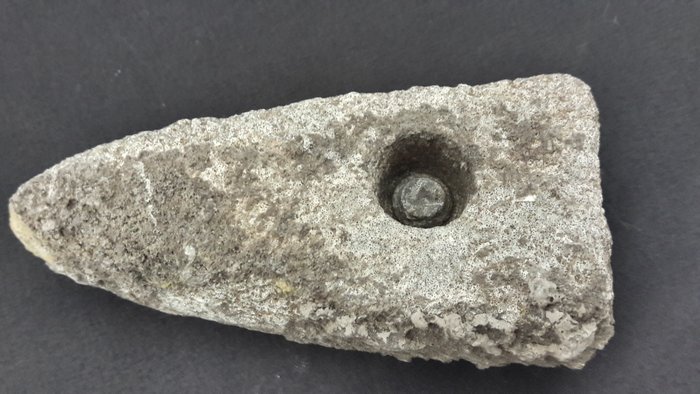
Neolithic Stone Point butted axe - 20.5×4×6 cm
No. 21099063

No. 21099063

Important Neolithic Stone Age Battle Axe head with half-drilled / an incomplete shaft-hole. It was drilled in bigger size and broken and again was try to make Axe in smaller size but not finished...
Presented Axe with an incomplete Shaft Hole confirming the use of Tibia (empty) Bones for Drilling Process.
Many questions still remain however, mainly those about the methods used to drill as well as the types of drill bits and contraptions in which they were used. Some questions are answered by archaeological finds, for example next to axes with holes drilled right through we find others which are unfinished (Brodnicki 1991, Fig. 55, Grygiel 1986, Fig. 133.1; Lebmann 1932, Fig1; Prike, Skoczylas 1980, Tabl. 8.39). Inside these holes we usually find a conical “core”,
their presence suggesting that the drill bit used was hollow (pipe borer – Clark 1957, p. 205). These conical cores, remaining after a hole was drilled through are also found on archaeological sites on their own, although rarely (Childe 1954, Fig. 116; Grygiel 1986, Fig. 134.6). Considering the resources available to the Neolithic people we can deduce that there is a high probability that they used bone for drill bits. This material however necessitated the use of a mineral powder under the drill, because it simply too soft for this purpose...
Size: Length 10,5 cm, Width 4,5 cm, diameter of shaft-hole: 15 mm.
Made of dense grey granite. Finely polished all over - fine ancient patina.
Beautiful and Important Neolithic Artefacts.
Please check actual photos for your own impression.
The Neolithic period was the last phase of Stone Age and is characterized by the use of ground or polished stone weapons, tools and implements.The Neolithic tools & weapons: axes and hammers, adzes and chisels, knives and scrapers, sickle and hoe were used for cereal cultivation and animal domestication.The Chalcolithic (or Eneolithic) era marks a transition period to the Bronze Age with the introduction of Bronze metallurgy. In Europe the arrival of bronze tools and weapons did not play a noticeable role in production for household or military craft. Stone still was used for implements or battle weapons. Many of them were multi-purpose tools that could be used as hoes, working axes, adzes, chisels and battle axes depending of the method of fastening the haft.
Authenticity Guaranteed
Provenance:
The seller warrants that they have obtained this lot in a legal manner.
Purchased by the Vendor in 2005, Leipzig, Germany from collector Ms. Inka Khmelinska.
Previously in Poland private collection formed at the beginning of 20th Century.
Statement of provenance held on file by Catawiki.
Important Information:
Will be shipped by registered postal service
No need for export license when shipped to other EU countries.
The seller of this lot hereby guarantees that this object was obtained legally.
The seller will inform the buyer about this if acquiring the proper permits and shipping the lot takes more than a few days.
How to buy on Catawiki
1. Discover something special
2. Place the top bid
3. Make a secure payment